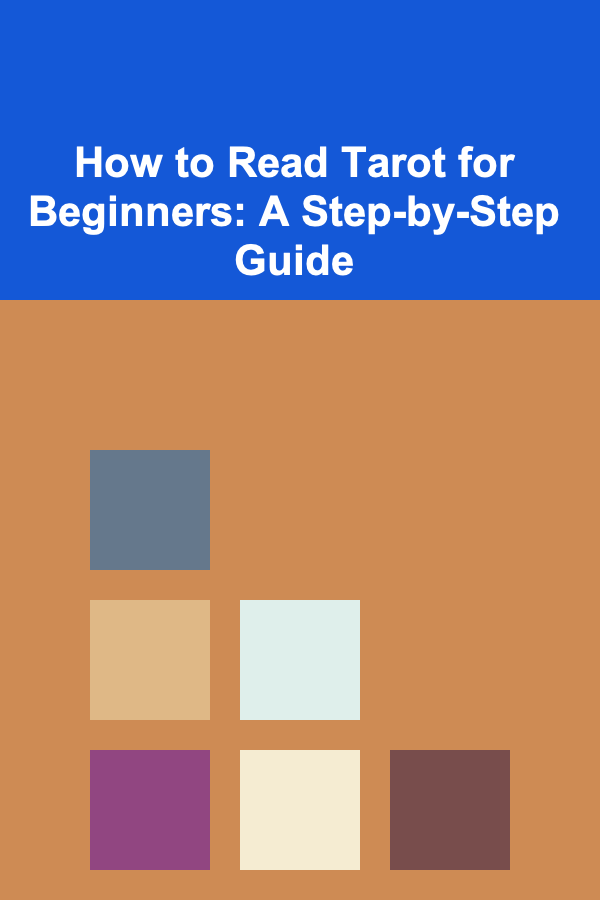
How to Read Tarot for Beginners: A Step-by-Step Guide
ebook include PDF & Audio bundle (Micro Guide)
$12.99$8.99
Limited Time Offer! Order within the next:

Tarot reading is a fascinating and deeply spiritual practice that has captivated individuals for centuries. For many, it serves as a means of gaining insight, understanding their current life path, and even preparing for what the future might hold. However, for beginners, learning how to read tarot can seem like a daunting task. The deck consists of 78 cards, each with its own unique symbolism, which can feel overwhelming at first.
In this article, we will walk you through the process of learning how to read tarot step-by-step. Whether you're curious about using tarot for personal guidance, or you simply want to explore its rich history and tradition, this guide is designed to help you navigate the tarot world with ease and confidence.
What is Tarot?
Before diving into how to read tarot, it's important to understand what tarot cards are and their purpose. Tarot is a deck of cards used for divination or gaining insights into situations, questions, or problems. Each tarot card holds a specific meaning that can be interpreted in various ways depending on the question asked, the surrounding cards, and the reader's intuition.
The traditional tarot deck consists of 78 cards, divided into two main sections:
- The Major Arcana (22 cards) - These cards represent significant life events or archetypes. They depict universal themes and key moments in a person's spiritual or psychological journey.
- The Minor Arcana (56 cards) - These cards represent day-to-day situations and emotions. They are divided into four suits, each with its own themes and meanings.
Getting Started with Tarot
Before you can begin reading tarot, there are a few foundational steps you need to take to prepare yourself. Here's what you should know:
1. Choose Your Tarot Deck
The first step to getting started is choosing the tarot deck that feels right for you. There are countless tarot decks available, each with its own unique imagery and design. While the symbolism behind the cards is generally consistent across different decks, each deck's artwork can evoke different emotions and interpretations. Some popular decks include:
- The Rider-Waite Tarot Deck - The most widely used and recognized deck, perfect for beginners.
- The Thoth Tarot Deck - Known for its complex symbolism and deep philosophical meanings.
- The Wild Unknown Tarot - A more modern deck, often loved for its simplicity and minimalistic design.
When choosing a deck, look for one that resonates with you on a personal level. If you're drawn to the artwork and feel an emotional connection, that's a good sign it's the right deck for you.
2. Cleanse and Prepare Your Deck
Before you begin using your tarot deck, it's important to cleanse it. Just like any other spiritual tool, tarot decks can absorb energy, so it's essential to clear any unwanted or negative energies from your deck. There are several ways to cleanse your cards, including:
- Smudging: Light sage or palo santo and pass the deck through the smoke to clear the energy.
- Using crystals: Place clear quartz or amethyst crystals on your deck to clear negative energy.
- The moon: Leave your deck under the light of the full moon for a night to cleanse and recharge it.
This cleansing ritual helps ensure that your readings are clear, accurate, and aligned with your highest good.
3. Set Your Intention
Tarot reading is a spiritual practice, so setting your intention before each reading is essential. Whether you are looking for clarity, guidance, or insight into a particular situation, take a moment to focus on your question or intention before you begin the reading. You may want to meditate or sit quietly for a few minutes to align your energy with your goal.
Understanding the Structure of the Tarot Deck
A basic tarot deck is divided into two main sections: the Major Arcana and the Minor Arcana. Understanding the symbolism and themes of these cards is crucial for accurate readings.
The Major Arcana (22 Cards)
The Major Arcana represents major life events or significant spiritual lessons. These cards often reflect turning points, transformative periods, or major decisions. When they appear in a reading, they indicate that the question or situation is of great importance and will have lasting impact. Here are some key cards in the Major Arcana:
- The Fool: The beginning of a journey, innocence, and spontaneity.
- The Magician: Manifestation, skill, and resourcefulness.
- The High Priestess: Intuition, hidden knowledge, and mystery.
- The Lovers: Relationships, choices, and alignment of values.
- The Tower: Sudden change, upheaval, and revelation.
- The World: Completion, accomplishment, and fulfillment.
The Minor Arcana (56 Cards)
The Minor Arcana is divided into four suits: Cups , Wands , Swords , and Pentacles. Each suit represents different aspects of life and the human experience:
- Cups: Emotions, relationships, and intuition.
- Wands: Creativity, action, and ambition.
- Swords: Intellect, communication, and conflict.
- Pentacles: Material world, career, and finances.
Each suit contains 14 cards, ranging from Ace to 10, plus four Court Cards (Page, Knight, Queen, King). These cards represent day-to-day situations and challenges you may encounter in your personal or professional life.
How to Shuffle and Draw the Cards
Now that you have your deck and an understanding of the cards, it's time to begin the reading. While there's no right or wrong way to shuffle your cards, here are a few basic guidelines:
1. Shuffling the Deck
Shuffling the cards is an essential part of the process as it helps to energetically mix the cards, ensuring that the reading is random and unbiased. You can shuffle the cards using the traditional overhand shuffle, or simply cut the deck a few times while focusing on your question. Trust your intuition during this process.
2. Cutting the Deck
Once the deck is shuffled, you may choose to cut the deck. This is another way to ensure that the cards are mixed and ready for a clear reading. Some readers also have the querent (the person asking the question) cut the deck.
3. Choosing the Cards
There are many ways to choose cards, depending on the type of spread you are using. For a beginner, the three-card spread is a great place to start. In this spread, you draw three cards representing the past, present, and future. Other spreads, such as the Celtic Cross or Seven-Card Spread, can be more advanced but provide deeper insight into complex situations.
Interpreting the Cards
Each tarot card has a set of meanings, but interpretation also depends on the surrounding cards and your intuition. While you can refer to a guidebook to understand the traditional meanings, it's essential to listen to your inner guidance and how the cards make you feel.
1. Look at the Card's Imagery
Start by observing the imagery on each card. What colors, symbols, or figures stand out to you? The visual cues can offer important insights into the message of the card. For example, in the Nine of Cups, the image of a person sitting with a satisfied look on their face suggests contentment and fulfillment.
2. Consider the Card's Position
The position of the card in the spread also affects its meaning. For example, in the three-card spread, the past card may represent influences that have led to the current situation, while the future card suggests potential outcomes based on the current trajectory.
3. Combine Cards Together
Tarot readings often involve synthesizing the meanings of several cards at once. For example, if you draw the Three of Swords (indicating heartbreak or emotional pain) next to the Empress (indicating nurturing and growth), it may suggest that healing is possible through self-care and compassion.
Developing Your Intuition
As a beginner, it's natural to rely on guidebooks or traditional card meanings for interpretations. However, over time, you'll develop your own intuitive understanding of the cards. Here are some tips for strengthening your intuition:
- Journaling: Keep a tarot journal to document your readings, your thoughts, and any intuitive insights. This will help you see patterns and deepen your understanding of the cards.
- Meditation: Spend time meditating with the cards. You can choose one card a day to meditate on, allowing its energy to guide you.
- Practice: The more you practice, the more comfortable you'll become with interpreting the cards intuitively. Try pulling a card daily for self-reflection or use simple spreads to deepen your practice.
Conclusion
Learning to read tarot is an ongoing journey of self-discovery, intuition, and spiritual growth. By following the steps outlined in this guide, you'll have a strong foundation to start using tarot for personal guidance, clarity, and insight. Remember, there's no right or wrong way to read the cards---tarot is a deeply personal and intuitive practice that evolves over time. As you continue to connect with your deck, trust your instincts, and embrace the magic of tarot, you'll find that it becomes an invaluable tool for understanding yourself and the world around you.
Reading More From Our Other Websites
- [Home Renovating 101] How to Choose the Right Roof Material for Your Home
- [Home Budget Decorating 101] How to Create an Affordable Kitchen Update on a Budget
- [Personal Care Tips 101] How to Incorporate Vitamins into Your Personal Care Routine
- [Organization Tip 101] How to Protect Your Home from Cyber Threats
- [Rock Climbing Tip 101] Choosing the Right Belay Device: A Comprehensive Comparison Guide
- [Home Cleaning 101] How to Clean Hardwood Floors: Tips for Maintaining a Lustrous Finish
- [Organization Tip 101] How to Maximize Small Home Office Spaces
- [Home Lighting 101] How to Use Task Lighting to Improve Functionality in Every Room
- [Home Family Activity 101] How to Create a Family Time Capsule: Preserving Memories for Future Generations
- [Home Lighting 101] How to Add Accent Lighting to Elevate Your Home's Decor

How to Create a Family Garden Project to Enjoy Together
Read More
How To Leverage User-Generated Content
Read More
How to Make Money Online as a QA Tester: 10 Actionable Ideas
Read More
Navigating the Digital Landscape: A Web Content Manager's Handbook
Read More
What Should You Know About Organizing Your Bathroom Products?
Read More
How to Understand the Concept of FatFIRE Without Being Rich
Read MoreOther Products

How to Create a Family Garden Project to Enjoy Together
Read More
How To Leverage User-Generated Content
Read More
How to Make Money Online as a QA Tester: 10 Actionable Ideas
Read More
Navigating the Digital Landscape: A Web Content Manager's Handbook
Read More
What Should You Know About Organizing Your Bathroom Products?
Read More